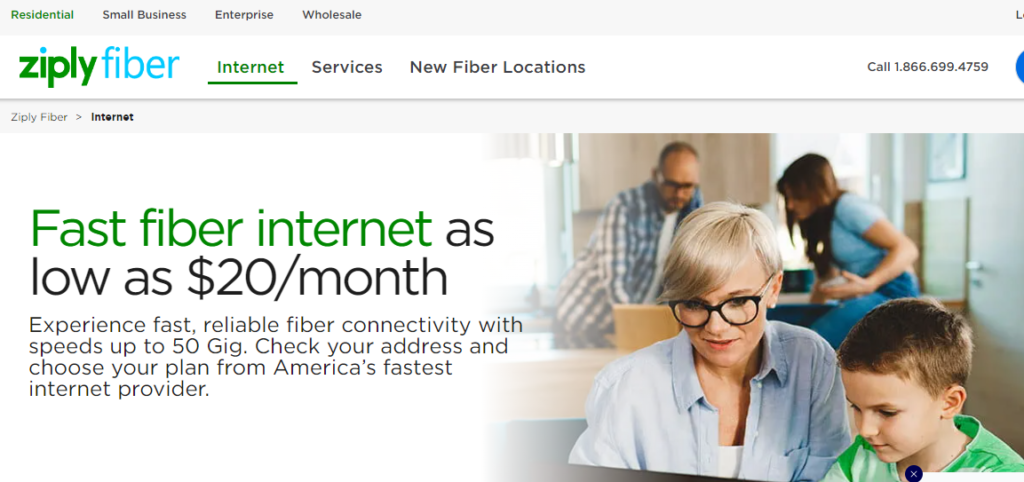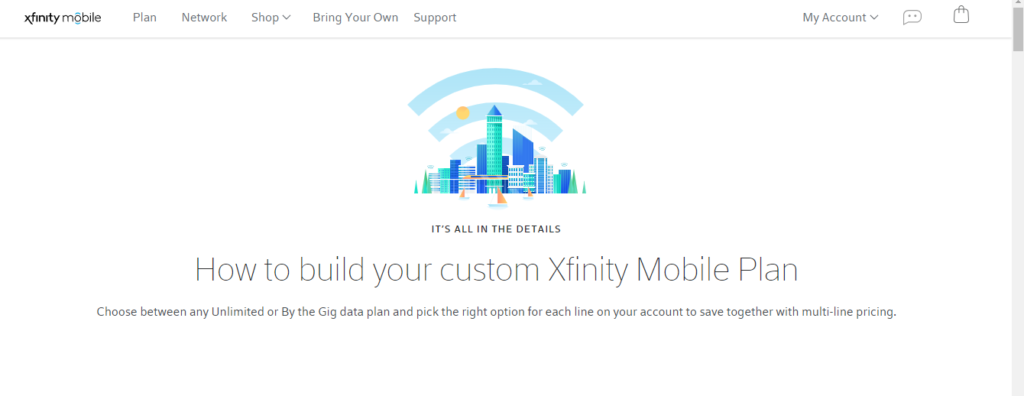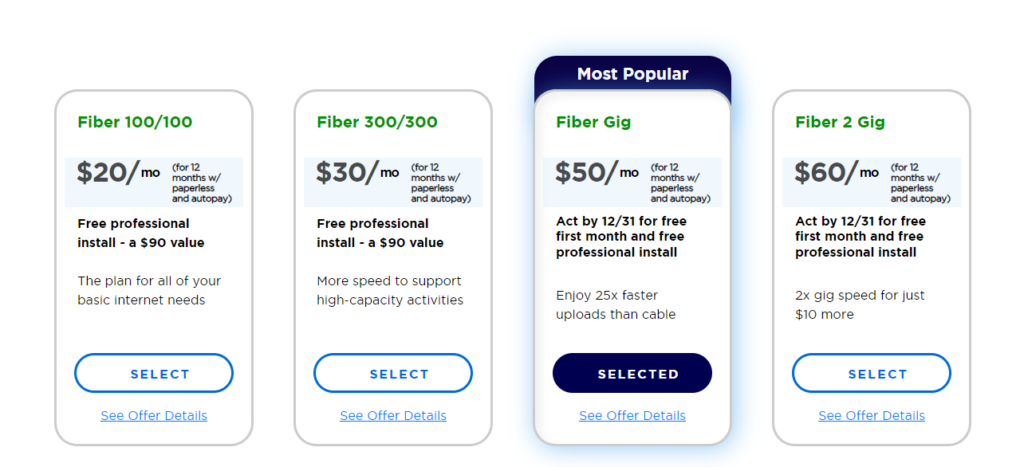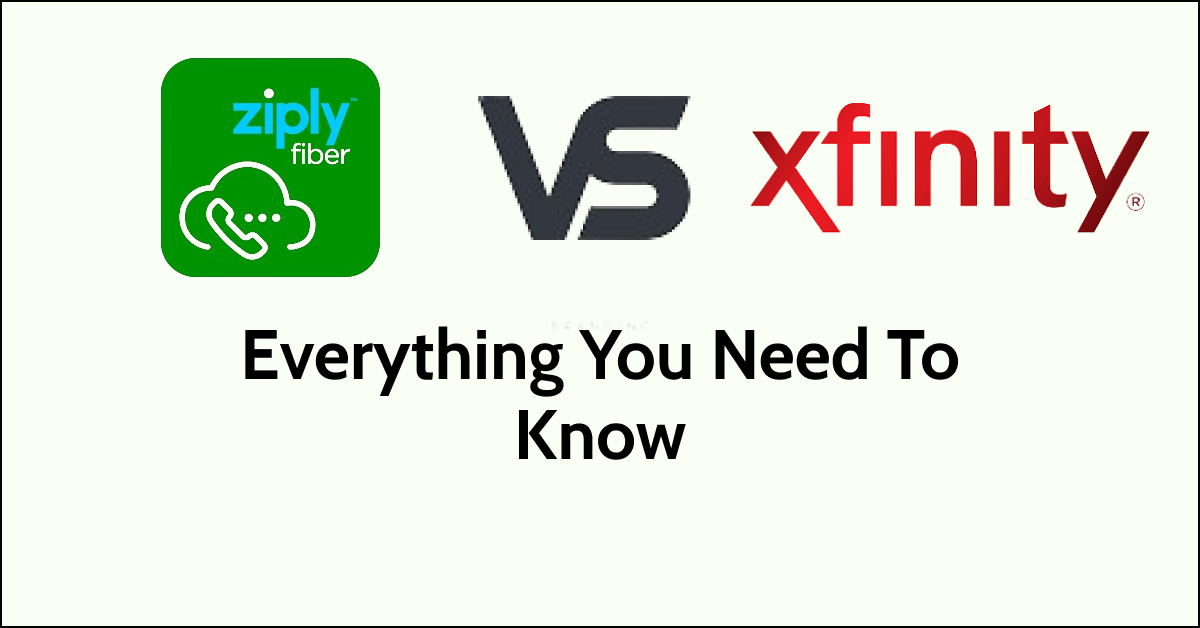When choosing an internet service provider, it’s essential to consider all aspects of what they offer, from prices to network availability.
Comparing Ziply Fiber and Xfinity, two well-known ISPs, can help you make a well-informed decision.
Ziply Fiber, known for its dedication to utilizing fibre-optic technology, offers significant speed and reliability advantages, while Xfinity, a more established player in the market, provides a broad range of services and wide-ranging coverage.
Every plan comes with its set of features and it’s important to understand what fits your specific needs. In this blog post, Let’s explore Ziply Vs Xfinity to identify your best choice.
Ziply Vs Xfinity: Overall Feature Comparison


Creating a detailed comparison between Xfinity and Ziply Fiber involves examining various aspects of their service offerings, including internet speeds, pricing, data caps, contracts, customer service, and additional features.
| Feature | Xfinity (Comcast) | Ziply Fiber |
|---|---|---|
| Service Type | Cable and fibre Optic (depending on area) | Fiber Optic |
| Internet Speeds | Varies by location: from 50 Mbps to 1,200 Mbps (1.2 Gbps) | Varies by location: from 30 Mbps to 1 Gbps |
| Data Cap | Typically 1.2 TB in most areas, unlimited data plans are available at an extra cost | Unlimited data with no caps |
| Contract | Optional; typically 1-2 years with possible early termination fees | No contract is required with no early termination fees |
| Pricing | Promotional rates for the first 12 months, then prices increase | Competitive pricing with no rate hikes after 12 months |
| Installation Fees | Self-installation or professional installation for a fee | Offer free installation promotions |
| Equipment Rental | Modem and router rental fee | Equipment included or you can use your own |
| Bundling Options | Offers bundles with TV, internet, and phone services | Offer internet and phone bundles are available |
| Customer Service | Mixed reviews; large customer base with varying experiences | Generally positive reviews, with a focus on local customer service |
| Additional Features | Xfinity Stream app, Xfinity hotspots, advanced security features, and Flex 4K streaming box (with certain plans) | Whole-home WiFi, 24/7 local customer support, and no hidden fees |
In conclusion, Ziply Fiber could be considered best for those who value a no-contract fiber-optic service with consistent pricing and unlimited data.
Xfinity may be the better option for those who need the highest possible speeds, want a comprehensive bundle with TV, or appreciate additional features like streaming apps and hotspots.
Your specific needs and preferences will ultimately determine which provider is best for you.
Ziply Vs Xfinity: Plan Comparison
Ziply Fiber Internet Plans

| Plan Name | Speed (Up/Down) | Price/M | Promotion | After 12 month |
|---|---|---|---|---|
| Fiber 100/100 | 100 Mbps | $20 | 12 months w/ paperless and autopay | $30 |
| Fiber 300/300 | 300 Mbps | $30 | 12 months w/ paperless and autopay | $60 |
| Fiber Gig | 1 Gbps | $50 | 12 months w/ paperless and autopay + Act by 12/31 for free first month | $80 |
| Fiber 2 Gig | 2 Gbps | $60 | 12 months w/ paperless and autopay + Act by 12/31 for free first month | $90 |
Xfinity Mobile Plans

| Unlimited Data Option | 1 | 2 | 3 | 4 | 5-10 Lines |
|---|---|---|---|---|---|
| Intro | $45/mo | $30/mo each | $30/mo each | $30/mo each | +$20/mo each added line |
| Plus | $55/mo | $40/mo each | $40/mo each | $40/mo each | +$30/mo each added line |
| Premium | $65/mo | $50/mo each | $50/mo each | $50/mo each | +$40/mo each added line |
Xfinity By the Gig Plans
| Data Amount | 1 Line | 2 Lines | 3 Lines | 4 Lines | 5-10 Lines | Additional Cost |
|---|---|---|---|---|---|---|
| 1 GB | $15/mo | $15/mo | $15/mo | $15/mo | $15/mo | $15/GB if over |
| 3 GB | $30/mo | $30/mo | $30/mo | $30/mo | $30/mo | $15/GB if over |
| 10 GB | $60/mo | $60/mo | $60/mo | $60/mo | $60/mo | $15/GB if over |
When comparing Xfinity and Ziply Fiber based on the provided information, here are the key points to consider:
Ziply Fiber
- Offers home internet service with a focus on high-speed fibre-optic connections.
- Plans range from 100 Mbps to 2 Gbps and are priced competitively, especially when customers opt for paperless billing and autopay.
Xfinity Mobile
- Mobile data plans with options for unlimited data or pay-by-the-gig.
- Features and pricing are based on streaming quality and mobile hotspot data, with prices decreasing per line as more lines are added.
- The By the Gig plans offer shared data across devices with the flexibility to pay for additional data if needed.
- Xfinity Mobile also includes 5G access where available.
Here’s a summary:
- Ziply Fiber is suited for home internet users who need reliable fibre-optic speeds, with no contracts and a 30-day money-back guarantee on the top-tier plan. The price will be higher after 12 month period. The prices are subject to change.
- Xfinity Mobile caters to mobile users with flexible data options, including unlimited plans with varying features and By the Gig plans for lighter or variable data use.
- Both services offer promotions and incentives to new customers, such as discounted rates for the first 12 months or free installation, but the services they provide are fundamentally different, catering to home internet versus mobile data needs.
Additional Benefits
Ziply Fiber users can enjoy benefits such as no data caps on most plans, which means you do not have to worry about overage fees.
Xfinity differentiates itself with the Xfinity xFi gateway which provides enhanced security features and parental controls, along with access to a vast network of public Wi-Fi hotspots nationwide, thus keeping you connected even when on the move.
Ziply Vs Xfinity: Service Quality & Reliability
When selecting Ziply Fiber and Xfinity for your internet service provider, you should consider both service quality and reliability to ensure consistent connectivity for your needs.
Ziply Vs Xfinity: Network Infrastructure
| Feature | Ziply Fiber 300/300 | Xfinity Hybrid Fiber-Coaxial |
|---|---|---|
| Network Type | Fiber-Optic | Hybrid Fiber-Coaxial |
| Speed (Up/Down) | 300 Mbps / 300 Mbps | Varies, e.g., 300 Mbps / 10 Mbps |
| Symmetrical Speeds | Yes | No |
| Best For | – Working from home – Frequent uploading of content | – High-speed internet needs with less emphasis on upload speeds |
| Reliability | Typically more reliable due to fiber technology | Generally reliable, but can be affected by network congestion |
| Upload Capacity | High (equal to download capacity) | Lower compared to the download capacity |
In summary, if your internet usage involves significant uploading, requires symmetrical speeds, or if you’re located in an area where Ziply Fiber’s network is available and reliable, Ziply Fiber would likely be the better choice.
However, if your internet activities are more download-centric and you’re looking for a provider with a broad service range and established network, Xfinity could be the preferred option.
Ziply Vs Xfinity: Uptime Statistics
| Feature | Xfinity | Ziply Fiber |
|---|---|---|
| Infrastructure | Robust, established network | Fiber-optic technology |
| Uptime | Generally excellent | Expected to be consistent due to fibre stability |
| Service Reliability | High reliability with a two-year price guarantee indicating confidence | Less prone to weather or electrical issues, potentially offering higher reliability |
| Outage Susceptibility | Can be affected by local infrastructure issues but generally offers good uptime | Fiber-optic is less susceptible to outages from weather or electrical issues |
| Market Presence | Veteran provider with established uptime statistics | Newer to some markets, uptime statistics may be less established |
If you prioritize a proven track record with a wide coverage area and additional services such as TV and phone, Xfinity might be the best choice.
Their two-year price guarantee and robust network offer reliability that many customers value, especially if you live in an area where Xfinity has a strong presence.
On the other hand, if your primary concern is internet speed and reliability, particularly for uploads, and you reside in the Northwestern region of the U.S., Ziply Fiber could be the better option.
Ziply Vs Xfinity: Network Availability
When you’re comparing Ziply Fiber and Xfinity, understanding where these services are available is crucial. Let’s look into how each provider fares in terms of regional coverage and network expansion.
Regional Coverage Area
| Provider | Coverage Area | Regional Focus | National Footprint | Market Presence |
|---|---|---|---|---|
| Ziply Fiber | Northwestern U.S. (Washington, Oregon, Idaho, Montana) | Strong commitment to the Northwest | Limited to the Northwest | Rapidly growing in its focused regions |
| Xfinity | Nationwide | Broad service provision | Extensive, available in many cities and states across the U.S. | One of the largest providers with a wide-reaching presence |
Ultimately, both Ziply Fiber’s regional dedication to fibre-optic excellence and Xfinity’s expansive, varied network expansion reflects their ongoing efforts to meet and exceed customer expectations in their respective markets.
Ziply Vs Xfinity: Network Expansion Efforts
| Aspect | Ziply Fiber | Xfinity |
|---|---|---|
| Network Expansion | Actively increasing fiber-optic infrastructure | Upgrading and expanding network, including fiber-optic solutions |
| Focus of Expansion | Enhancing speed and reliability in the Northwest | Improving availability and quality nationwide |
| Type of Infrastructure | Fiber-Optic | Hybrid Fiber-Coaxial and Fiber-Optic in select areas |
| Regional Emphasis | Northwestern U.S. (Washington, Oregon, Idaho, Montana) | Nationwide, with a focus on both urban and suburban areas |
| Customer Impact | Faster and more reliable internet service | Increased coverage and enhanced service quality |
Ziply Vs Xfinity: Customer Satisfaction
| Aspect | Ziply Fiber | Comcast Xfinity |
|---|---|---|
| Contract Requirement | Contract-free plans | May require contracts for certain promotions or bundled services |
| Installation Services | Free installation services | Installation services may have a fee, but promotions for free installation may be available |
| Availability | Limited to specific regions in the Northwestern U.S. | Broad availability across a significant portion of the country |
| Service Options | Primarily internet service | The broad range of services including internet, cable TV, telephone, and home security; bundled options available |
| Pricing | Competitive pricing for fibre-optic service | Potentially higher price point, but bundled services may offer savings |
In summary, Ziply Fiber may be preferable for those in the Northwest seeking a no-contract, fiber-optic internet solution with straightforward pricing, while Xfinity could be the choice for those looking for a wide range of services and the convenience of bundling, albeit potentially at a higher cost.
